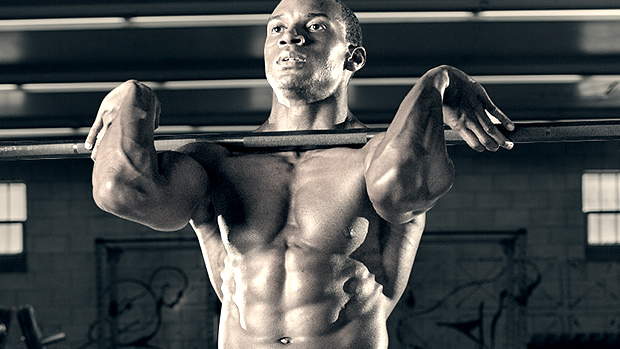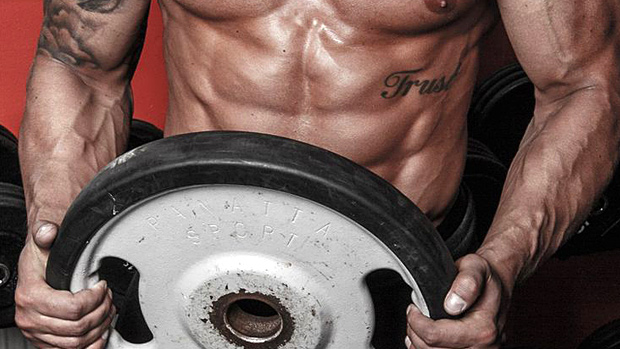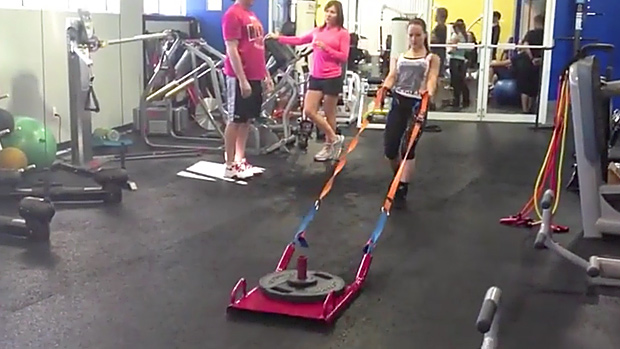Now, more than ever, guys are flocking in droves to the Olympic lifts. That's fantastic, but it never ceases to make me cringe.
So, what's the problem? The fact that they didn't start as a teenager, or better yet while they were still potty training. In fact, most of these new comers are past their thirties.
Why is this a recipe for disaster?
They've lost their youthful flexibility, resilience, and ability to hold the correct positions for the demands of the Olympic lifts. As a youth, gravity hasn't taken it's toll from the hours spent sitting down and slouching forward, leading to poor upper thoracic posture and ridiculously tight hamstrings.
At this point, they've lost the ability to adequately bend at the ankles, knees, and hips correctly to get in the correct pulling position, much less get under the bar correctly in a full squat position. Simply bending down to pick up the bar has become a near impossible task.
Add these poor positions and faulty mechanics to receiving positions that look like the profile of a humpback whale, and voilà, you have anything from a herniated disc to a blown shoulder. And depending on where the bar lands, you're looking at potentially fractured wrists, femurs, or further spine damage.
But all of this can be remedied with some select prep drills. That is unless you want to continue doing power cleans from the high hang position for your whole life, and really, what fun is that? You know you want the full snatch!
Flexibility, It's for You Too
While many people see the grace and power demonstrated in the Olympic lifts, many seem to overlook the extreme flexibility required to perform them adequately.
While the best in the world make the snatch and clean and jerk look flawless and easy, don't misunderstand. Years have been spent working basic positions in order to violently heave weight into a beautiful ass-to-grass position and rebound gracefully to the overhead finish. Think of these movements much like gymnastics and golf. Positions and precision first, and then you can jump headfirst into a nice, fat snatch.
And I'm not even talking about simply doing the classic, or squat, versions of the lifts.
For both the classic (catching the bar ass-to-grass) and the power versions (catching the bar above parallel with the femurs), the first thing any trainee must focus on is proper positions, which in fact is nearly equal parts strength and flexibility. The inability to get into these positions will expose muscle imbalances, overly tight or weak muscles, and force you to pull incorrectly with the wrong biomechanics, and therefore, the wrong muscles and pull sequences.
On the other hand, if due diligence is given to training the positions required for each lift, your learning curve to mastery is greatly shortened. Likewise, your relative strength in each position will determine how much of a load will be possible. Then, it's very easy to pinpoint your weak spots, train them, and continue on with more personal records.
The Prep Before the Prep
Each lift has their special position requirements and corresponding flexibility exercise. However, before we get to them, go no further without first having had a healthy diet of the following exercises. These are the mandatory, full range of motion movements required before you ever plan to do a snatch or clean and jerk.
If you have no strength in these basic moves, you'll ultimately get crushed when your limit strength is achieved.
- Front squat
- Back squat
- Overhead squat
- Clean-grip deadlifts
- Snatch-grip deadlifts
- Lunges
- Military presses
Once you've worked the kinks out of these movements and are strong, stable, and flexible, then it's reasonable to consider jumping violently into these positions with not only a barbell but also some weight, instead of attempting the former and hoping for the best.
Unique Stretches for the Olympic Lifts
But that isn't all that's required to really prepare you for the Olympic lifts. There are a few key positions and stretches. And don't get scared by the word "stretch;" these are isometric strength moves in disguise, which are actually stretching their tight antagonistic counterparts.
The Snatch
Snatch-Grip Squatting Quad Stretch

- Goal: To prepare for the optimal pulling center of gravity from the floor. It's also a great stretch for the ankles, knees, and hips for the receiving positions (or ass-to-grass squat positions).
- Execution: With a snatch grip, place the bar on your mid thigh and squat as low as your anatomy will allow while maintaining an erect torso, properly arched back, and weight on the ball of your feet and heels. Push the bar into your thighs to increase the stretch and keep the proper balance.
Snatch-Grip Overhead Lockout

- Goal: To prepare the body for the feeling of the finish position overhead, and to prepare for the descent into a squatting position with the barbell overhead. Also it's used to achieve the optimal center of gravity over the balls of the feet, hips, shoulder blades, and ears.
- Execution: With a snatch grip and your feet in your normal squat stance, press the bar overhead, locking it out over your ears and shoulder blades. Shrug your shoulders and traps to your ears, as well as your whole body as if you're trying to support 500 pounds over head.
Overhead Squat

- Goal: To prepare the bottom position at which you'll receive, settle, and stabilize the barbell after violently propelling it into vertical space. The final portion of the lift is to jump under the barbell as it continues to fly vertically and your body drops down under the bar. The faster and lower you can get there the better your lift will be.
- Execution: With the barbell still overhead, descend into a full-range squat (or hips below knees and/or to where the hams are touching the calves) with the bar remaining over the optimal center of gravity over the balls of your feet and heels, hips, shoulder blades, and ears. This is where you may find most of your problems, and you'll know if and when you should try some classic full-squat snatches.
A sample drill with these movements before a snatch session would be to go from one position to the next without stopping. After each position is held for the designated time, move to the next and repeat for as many sets as necessary.
- A1. Snatch-grip squatting quad: for 10 seconds
- A2. Snatch-grip overhead lockout: for 10 seconds
- A3. Overhead squat: for 10 seconds
The Clean
Clean-Grip Squatting Quad Stretch

- Goal: To prepare for the optimal pulling center of gravity from the floor and as a great stretch for the ankles, knees, and hips for the receiving positions (or ass-to-grass squat positions).
- Execution: With a clean grip, place the bar on your mid thigh and squat as low as your anatomy will allow while maintaining an erect torso, properly arched back, and weight on the balls of the feet and heels. Push the bar into your thighs to increase the stretch and keep the proper balance.
Clean-Grip Front Squat Rack Position
- Goal: To prepare your receiving position for the clean. It stretches the wrists, elbows, and shoulders to allow for proper receiving and front squatting positions so you don't slump forward, putting the weight on your back, or risk dumping it forward onto your legs.
- Execution: With a clean grip, place the bar on your clavicles and push your shoulders up and forward to build a rack for the barbell. Once the bar is securely placed, grip the bar tightly with your whole hand and drive your elbows upward to the sky. Note: On the rack position in the clean, you will not hold the bar tightly like this; the tight grip is merely for stretching purposes.
Front Squat

- Goal: To prepare the bottom position at which you'll receive, settle, and stabilize the barbell after violently propelling it into vertical space. Just as in the snatch, the final portion of the lift is to jump under the barbell as it continues to fly vertically and your body drops down under the bar. The faster and lower you can get there the better your lift will be.
- Execution: With the barbell in the racked position on your shoulders, descend into a full-range squat (or hips below knees and/or to where the hams are touching the calves) with the bar remaining over the optimal center of gravity over the balls of the feet and heels, hips, and rack position. Just as in the snatch, this is where you may find most of your problems, and you'll know if and when you should try some classic, full-squat cleans.
While adhering to the same rules previously mentioned for the snatch drills, a sample drill with these movements before a clean session would look like this:
- A1. Clean-grip squatting quad: for 10 seconds
- A2. Clean-grip overhead lockout: for 10 seconds
- A3. Front squat: for 10 seconds
The Jerk
Jerk Rack Position 1 and 2

- Goal: To prepare the rack position to drive energy into the bar without letting the arms take over, robbing the energy transfer from the legs. There are two basic styles of jerk positions utilized: elbows either up or down.
- Execution: Very much like the clean-grip rack position, the bar will be on your collarbones. With your elbows down, the key is to get the shoulders popped out enough so that the arms aren't supporting the weight of the barbell. However, hands (or finger tips) are on the bar in order to lock the bar out overhead. If you want the elbows up, this is the same as the front squat rack position stretch.
Overhead Lockout

- Goal: To prepare the body for the feeling of the finish position overhead, and to prepare for the descent into a split squatting position with the barbell locked out overhead. It's also used to achieve the optimal center of gravity.
- Execution: With a jerk grip, press the bar overhead, locking the bar over the shoulder blades, hips, and balls of feet and heels. Shrug your shoulders and traps to your ears, as well as your whole body as if you're trying to support 500 pounds over head.

Overhead Lockout with Split Stance (or Squat Jerk)
- Goal: To prepare the bottom position at which you'll receive, settle, and stabilize the barbell overhead in a split or squat stance after violently propelling it into vertical space.
- Execution: Just as in the snatch and clean, the final portion of the jerk lift is to jump under the barbell as it continues to fly vertically and your body drops down under the bar into a split or squat stance. The faster and lower you can get there the better your lift will be.
Clean-Grip Overhead Squat

- Goal: If you plan to squat jerk instead of the split stance, this move is to prepare the jerk receiving position with the squat stance.
- Execution: Everything here is the same as in the split stance overhead lockout drill except the foot positions. This movement is also a great full body flexibility exercise.
Just like with the snatch and jerk, a sample drill with these movements before a clean session would be:
- A1. Jerk rack position: for 10 seconds
- A2. Overhead lockout: for 10 seconds
- A3. Overhead lockout with split stance or overhead squat: for 10 seconds
Additional Prep Drills
For those ready to podium in the clean and jerk, or for those just wanting to improve overall, there are two more prep drills to improve upon.
The Clean and Jerk Prep
- A1. Clean-grip squatting quad: for 10 seconds
- A2. Clean-grip front squat rack position: for 10 seconds
- A3. Front squat: for 10 seconds
- A4. Overhead lockout: for 10 seconds
- A5. Overhead lockout with split stance or overhead squat: for 10 seconds
Miscellaneous Basic Olympic Style Prep
- A1. Clean-grip squatting quad: for 10 seconds
- A2. Clean-grip front squat rack position: for 10 seconds
- A3. Overhead lockout: for 10 seconds
- A3. Back squat: for 10 seconds
- A4. Snatch-grip overhead lockout: for 10 seconds
- A5. Snatch-grip overhead squat: for 10 seconds
- A6. Front squat: for 10 seconds
- A7. Overhead lockout with split stance: for 10 seconds
Over (Your Head) and Out
Work these special barbell positions either daily or every time you perform the specific lift to loosen, lubricate, and prepare the area for war.
There will be substantial adjustments to these positions by all of the joints and connective tissues while you improve, but it won't come without some time and a few growing pains, especially after the age of thirty.
On the bright side, I've had several people over the age of fifty successfully perform the full versions of the lifts with this exact approach. Many of them hadn't even weight trained until after the age of fifty, but now they've fully implemented the Olympic lifts into their training arsenal.
With enough preparatory strength work and position stretches, you'll soon be able to snatch, clean, and jerk with authority.





